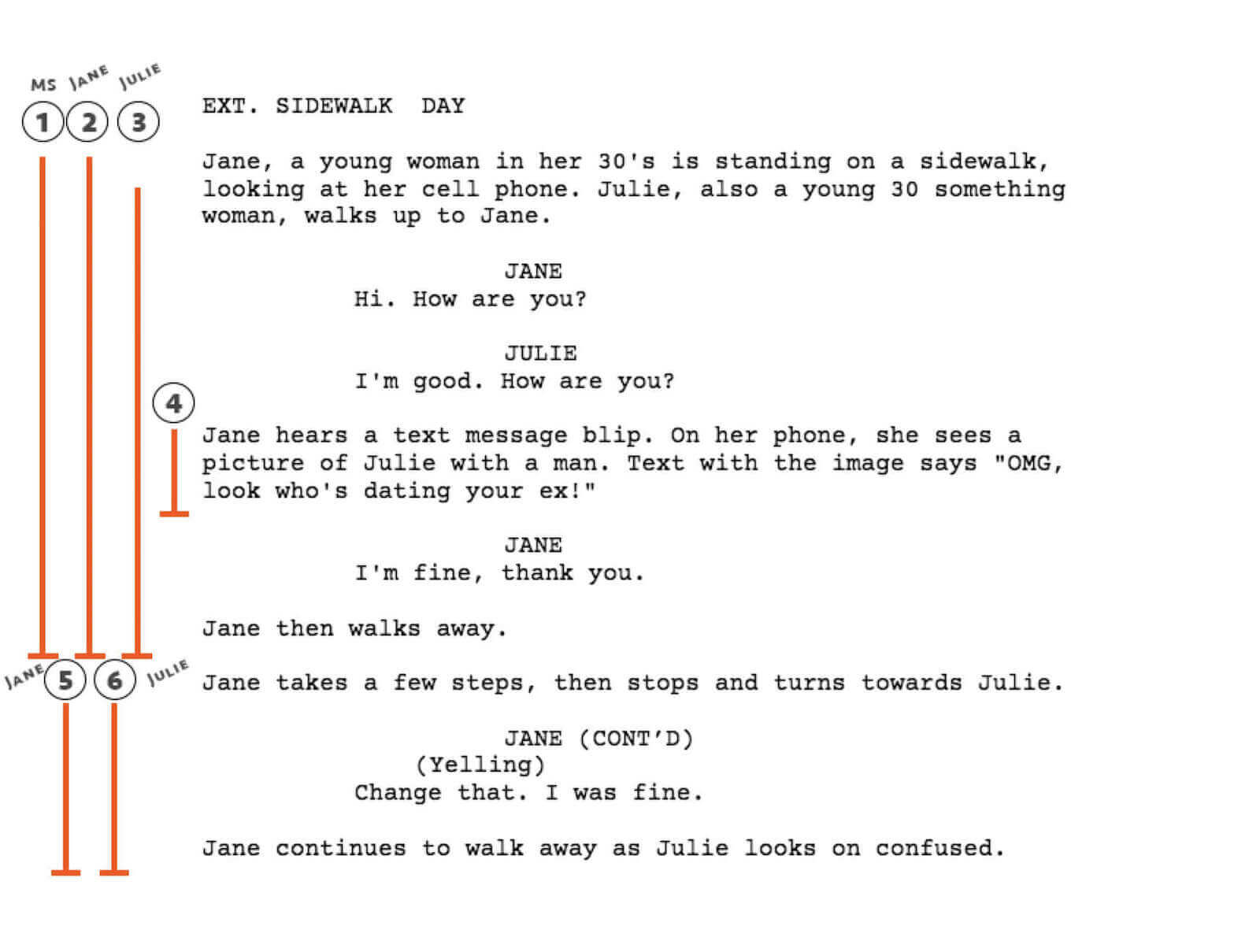W
hat is a lined script? And what does it have to do with your shot list?
On the surface, a shot list is exactly what it sounds like. A list of shots that communicates to your crew what camera shots you intend to get. Yet we all know once you get to set, issues arise and something always has to give. And that something is often your favorite camera angles.
But with a little forethought and a lined script, we can prepare our shoot to make sure we get everything we need. Here’s how you do it.
How to make a shot list online
How to Make a Lined Script and Save Your Shot List
1. Lining a script helps with coverage
It's important to remember that shot lists aren't just for your creative vision. They're a literal list of shots that helps the film crew know what camera position to set up before you ask them.
For more information on the subject, make sure to read this post on how to make a shot list which includes a shot list example and free template to get you started.
But whether you drew your shot list up in a shot list template or used tools like StudioBinder shot listing software, once you reach the set, things can start to go wrong.
And when things go wrong you have to lose, combine, or sometimes even add different types of camera shots to ensure your editor has the coverage they need by the end of your shoot day.
So how can we use a shot list to be better prepared before we get to set?
We’ll expand our shot list template by lining the script. A lined script will help us decide what different types of camera shots will give us the best coverage and prepare us for the inevitable changes to our camera angles once on set.
Watch: Lining Shots on Your Script by Pull My Focus
Related Posts
HOW TO MAKE A LINED SCRIPT AND SAVE YOUR SHOT LIST
2. How to create a lined script
Filling out your shot list template, then taking your shot list and lining the portions of a scene each shot covers begins the process of translating what you see in your head into the tangible medium of film and video.
You want potential issues to come to light now so you can plan for them. This is especially true on an independent film production where you'll be wearing multiple hats (managing the parking situation, for example.)
Wearing multiple hats equals an increased chance of missing something.
But with a little preparation and a lined script, you can set up your camera positions and get everything you need.
Let’s use a very simple script to demonstrate. Here we have two women, Jane and Julie, meeting on a sidewalk.

This seems simple enough, but when the camera rolls, it can get complicated quickly.
Let's line the script with a master 2 shot, shot 1, that covers the whole scene.
Here’s an example of the lined script and a screenshot of how it would look. Special thanks to Thea Samuelson (Jane) and Courtney Shaffer (Julie) as our actors.

A lined script indicating the master shot and the corresponding medium shot.
HOW TO MAKE A LINED SCRIPT AND SAVE YOUR SHOT LIST
3. Expand the lines
Now, let's add a single of Jane, shot 2. Specifically, a medium close-up shot.
Note that on the script I end it when she’s done talking, which means we don’t get footage of her leaving her single shot.
Let’s open up that shot, by lengthening that line, ensuring we know she needs to exit her single, giving our editor a choice in which camera shots to select.

Short version of shot 2 on the left, long version on the right.

Left: Jane single. Right: Jane exiting the medium close up shot
Let's add a single of Julie, shot 3, but open up the start of that shot so it’s clear we get her entering the shot.
We'll also open up the end, so we have a shot of Jane crossing her frame, with Julie turning her head to follow her. More camera angles, more editorial choices.

Short version of shot 2 on the left, long version on the right.

Julie entering her single shot.
HOW TO MAKE A LINED SCRIPT AND SAVE YOUR SHOT LIST
4. Add insert shots
We need an insert shot of Jane’s phone, which could be shot almost anytime on set. Since it’s a close-up, we could even use a stand-in’s hands if we have to.
This gives our shooting schedule flexibility but in the script, Julie is standing in front of Jane for that shot. This means she may have to be in the background.
If we think ahead, we can check that shot first and adjust how Jane holds her phone in her single, so we can get that insert shot without Julie in the background.
What if this scene was a hair longer, with Jane turning around after she walks away and yelling at Julie?

In case it isn't clear, Jane is not fine.
Let's have a slight tracking shot of Jane walking, shot 5, and a single medium shot of Julie turned, looking at Jane, shot 6.

Here’s how that lined script would look with all our shots.

Left: Jane wiping by in single. Right: Over Julie shoulder of Jane in a medium shot.
You’ll notice our shot lines all start and stop at one point. This indicates a point you’re forcing the editor to cut and limiting their choices. Let's open up the beginning of shot 6, Julie’s single, so we get Jane walking by her and wiping the camera.
We could also continue shot 3, Julie’s first single and move the camera into her over the shoulder on Jane.

Left: Jane wiping by in single. Right: Over Julie shoulder of Jane in a medium shot.
Related Posts
HOW TO MAKE A LINED SCRIPT AND SAVE YOUR SHOT LIST
5. Adjust the shots on set
You’re on set. You've filled in your shot list template.
And for reasons out of your control, you know you don’t have enough time to get everything.
What can you do? Two choices:
- Lose camera shots
- Combine camera shots
The key is to make sure you get the performances you need and leave choices for your editor.
We could lose the master shot as we only expect to use it in the opening anyways. Check your lined script to see if that leaves any holes.
We can combine Jane’s single, shot 2, with the tracking shot, shot 5. Two shots for the price of one. Mark it on your lined script.

Newly lined script
We’re now down to 3 interesting camera shots that give us choices and an insert we can shoot anytime.
HOW TO MAKE A LINED SCRIPT AND SAVE YOUR SHOT LIST
6. Hashmark off-screen dialogue
One additional trick to help out when you line scripts is adding hash marks to a shot where there’s off-screen dialogue (adding a series of angled parallel lines on the shot line).
For example, in shot 1, our two-person medium shot, we see and hear all the opening dialogue of the scene on camera. But in shot 2, Jane’s single, we only see Jane on camera, not Julie, so Julie’s line, “I’m good, how are you”? is off camera for that shot.
We'll hash mark that point on the shot 2 line in the script.

Hash marks in action.
For Julie's single, the opposite is true, she's on camera, Jane is off. When you hash mark a script, you give yourself an extra level of detail and focus on what the camera will and won’t capture in a shot.
This way we can confirm that all the dialogue is covered on at least one of our camera shots.

Hash mark the appropriate sections and you have a completely lined script
Related Posts
HOW TO MAKE A LINED SCRIPT AND SAVE YOUR SHOT LIST
7. Final shot of the day
Shooting a scene is never easy but when you prep your shot lists with a lined script, you can set yourself up to win, getting the camera shots you need during the inevitable chaos of production.
Lined scripts and shot list template not enough for you? Want to learn about how to make a shot list?
Watch our videos to learn how your favorite filmmakers plan their shots! Or sign up to use our shot list software to plan your own shoot.
Showcase your vision with elegant shot lists and storyboards.
Create robust and customizable shot lists. Upload images to make storyboards and slideshows.
